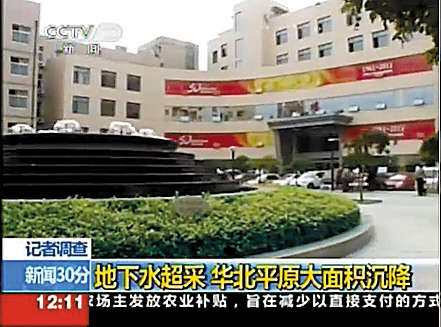Sinking North China Plain threatens development
- By Zhang Ming'ai
 0 Comment(s)
0 Comment(s) Print
Print E-mail
China.org.cn, November 2, 2011
E-mail
China.org.cn, November 2, 2011
An inpatient building of the Cangzhou People's Hospital in Hebei Province was once a three-story building. Gradually, it sank with the land and was reduced to two stories before being torn down and turned into a fountain.
 |
|
The inpatient building of the Cangzhou People's Hospital in Hebei Province was reduced to two stories before being torn down and turned into a fountain. |
Land subsidence, or the downward shift of land, in the North China Plain is not a new problem. Since the 1950s, constant land subsidence has occurred across nearly 70,000 square kilometers there, with some places sinking 3.18 meters and at an annual rate of more than 100 millimeters
Beijing, Tianjin, Tanggu and Cangzhou are the most affected areas – Cangzhou has sunk about 2.4 meters since the 1970s, said Wu Aimin of the Chinese Academy of Geological Environment Monitoring.
Land subsidence can be caused by a number of factors, including natural factors such as crustal movement, natural soil compaction and human factors, such as oil and gas pumping. But the recognized root cause of land subsidence in the North China Plain is the excessive extraction of underground water.
Since the 1980s, Beijing, Tianjin and Tanggu has extracted more than 600 million cubic meters of water over the accepted level every year, according to the Chinese Academy of Geological Sciences
Haihe basin has drained more than 100 billion cubic meters of underground water above the accepted level, nearly 70 percent of the amount of the water in the Poyang Lake, China's largest freshwater lake. And in 2010, 50 percent of Beijing's water supply came from underground water.
The Bohai-rim economic zone, where Beijing and Tianjin are situated, accounts for 30% of China’s GDP. Land subsidence caused by water shortages has become an impediment to the development of the economic zone, where Beijing and Tianjin are situated and accounts for 30 percent of China's GDP. In 2008, a five-year study by China Geological Survey showed that land subsidence had incurred a direct economic loss of nearly 40.5 billion yuan and an indirect economic loss of 292 billion yuan. As land subsidence increases, so will the economic losses.
In Beijing, the land is sinking at a maximum rate of 137 millimeters a year in economic and cultural boom areas such as Haidian and Chaoyang districts, said Yang Yan, a professor at the Beijing Institute of Technology, in an article.
The impact of land subsidence on buildings, roads and infrastructure in Beijing has become increasingly apparent. Since 2000, one third of Beijing's water pipeline damage was caused by land subsidence. Underground pipelines face the biggest challenge because land subsidence causes the pipelines to bend, deform or even break, while causing gas pipelines to fracture or roads to collapse.
Beijing's subway lines 10 and 13, as well as the Daxing and Yizhuang lines, all run across or near the subsidence area. Land subsidence constitutes to be a potential threat to railroad track. In 2005, a hole 3 meters wide and 2 meters deep formed 20 to 30 meters from a subway station. And in 2009, settlement of 1.85 centimeters near Xidan station affected nearly 40 square kilometers of road surface on Chang'an Avenue.
The land subsidence also has consequences for China's prized high-speed railways. The Beijng-Tianjin, Beijing-Shenyang and Beijing-Tanggu high-speed lines run across land subsidence areas. Taiwan's high-speed rail crisis serves as a direct lesson. The rail system, which cost NT$500 billion, might be forced to close in 10 years if the land subsidence problem cannot be solved.
According to the design of the Beijing-Shanghai high speed railway, which runs at a speed of 300 kilometers per hour, the land subsidence cannot exceed 5 millimeters over 100 years. As the railway runs across the world's largest land subsidence area, it raised high demands for early designs and later subsidence monitoring.
Underground water extraction control and optimization of underground water extraction are important measures to prevent land subsidence from worsening. Since March 1, Beijing has set strict limits on underground water extraction.
The South-to-North Water Diversion Project is also now seen as an important solution to the subsidence caused by over-pumping of groundwater in Beijing. Since the SNWDP began, Beijing has lessened its control on underground water reserves. Currently between 70 and 80 percent of Beijing's water supply comes from underground water. Even now, it is still unknown whether underground water resources will be replenished.
But land subsidence might also affect the safety of the water diversion project. Therefore, the project cannot solve the water crisis in the North China Plain or be a permanent cure to land subsidence.
Water conservation has been the key to a series of environmental, social and construction problems. For North China, it is urgent to develop water-saving agriculture. In 2007, Beijing announced it will remove all water-consuming industries, while Tianjin's industrial water consumption that year dropped by 20 percent.





